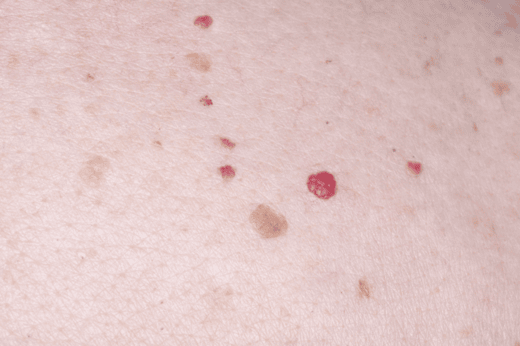
Angiomas are benign vascular skin lesions that form due to proliferating epithelial cells (cells that line the blood vessels). The most common type of Angioma is cherry Angioma, which usually develops in adulthood over 30. This type of Angioma is rarely seen in infants or children. Cherry angiomas are small, red bumps on your skin found in clusters resembling a bunch of cherries. Though the exact cause of these angiomas is unknown, it is believed that they may arise due to genetic predisposition. They are usually harmless and do not require treatment unless they bleed or cause irritation. Most often, people want to get them removed for cosmetic reasons. The treatment options may include electrodissection, cryotherapy, or laser therapy.
This blog will explore cherry angiomas to inform you about the condition. This can help you seek medical help when required.
Cherry angiomas, also known as senile angiomas or Campbell de Morgan spots, are small raised red bumps on your skin. They are usually benign and harmless and not a cause of concern unless they bleed or change appearance, which may be an early indicator of skin cancer. These pin-head lesions can appear anywhere in your body but are commonly seen on your torso, arms, and legs.
Cherry angiomas are light to dark red and range in size from 2mm to 4mm in diameter. An estimated 50% of adults have cherry angiomas on their skin after age 30, increasing to 75% as they age.
The exact cause of cherry angiomas is not known. However, several research studies have identified factors that increase your likelihood of developing cherry angiomas. These include:
Cherry angiomas are asymptomatic. They are red-colored, raised tiny bumps that may grow from 1 to 5 mm in diameter. They can be circular or oval. Cherry angiomas are typically red due to dilated capillaries. They usually do not cause pain, discomfort, tenderness, or itching and do not blanch on application of pressure.
However, the angiomas usually form round, doom shapes with smooth, flat tops as they get bigger.
Cherry angiomas are usually diagnosed through clinical appearance and do not require any additional diagnostic tests.
However, when the diagnosis is uncertain or if it may be confused with other skin conditions, a dermoscopy may help. A small piece of skin tissue is taken from the angiomas and studied under a microscope.
Most often, treatment for cherry angiomas is strictly cosmetic, as they do not pose any serious concerns. There are several options to treat cherry angiomas. These include:
Excision
Electrodissection
Cryosurgery
Laser Removal
Cherry angiomas are benign, harmless skin conditions that do not require you to rush to a doctor. However, if your angiomas bleed, itching, cause discomfort, or negatively impact your facial aesthetics, seek medical advice about the right treatment choice.
Cherry angiomas are common, benign, and harmless skin conditions that develop due to several factors like genetic mutation, aging, or hormone imbalance, though the exact cause is unknown. These usually appear as tiny pin-head, red-colored, raised bumps in clusters resembling a bunch of cherries.
Consult your doctor if you are doubtful about cherry angiomas for a thorough clinical examination to rule out other skin conditions or malignancies. Your doctor may recommend the removal of cherry angiomas either through excision, electrocautery, cryosurgery, or laser therapy.
Pregnancy increases the risk of cherry angiomas due to the high hormones (estrogen and progesterone) and prolactin (a hormone made by the pituitary gland) levels. These may reduce in size or completely disappear after delivery.
Several home remedies, such as apple cider vinegar, iodine, and tea tree oil, claim to shrink angiomas. However, proven scientific research is needed to confirm the effectiveness of these natural solutions.
Though you cannot wholly prevent cherry angiomas, you can follow the tips below to lower your risk.
The term eruptive cherry angiomas indicates the sudden development of multiple and extensive cherry angiomas. This may happen as a side effect of cyclosporine or topical nitrogen mustard.
Cherry angiomas can bleed occasionally and are considered normal. However, prolonged excess bleeding should be evaluated by a doctor.
Sclerotherapy helps treat cherry angiomas. To shrink the angioma bumps, your doctor may inject 3% sodium tetradecyl sulfate directly into the angioma bumps.
1. https://www.ncbi.nlm.nih.gov/books/NBK563207/
2. https://www.ncbi.nlm.nih.gov/pmc/articles/PMC7415270/
3. https://pubmed.ncbi.nlm.nih.gov/33085354/
4. https://pubmed.ncbi.nlm.nih.gov/36370831/
5. https://pubmed.ncbi.nlm.nih.gov/33252464/
6. https://www.ncbi.nlm.nih.gov/pmc/articles/PMC9949213/